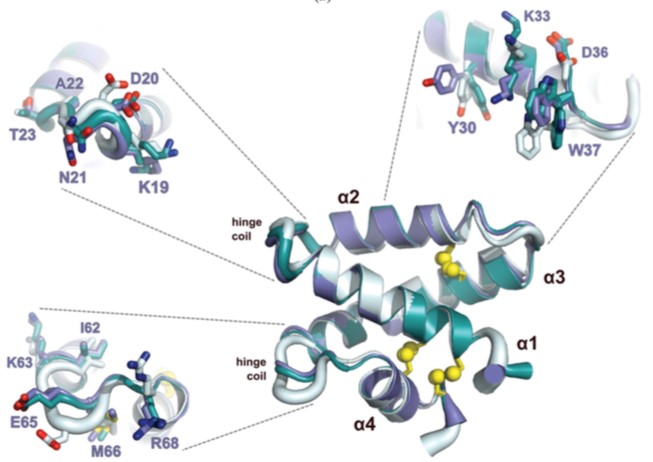Mempro™ Cell-Based Saposin Production
Creative Biostructure has built an excellent Mempro™ cell-based membrane protein production platform for saposins. Our unparalleled cell-based expression system can best preserve the native conformation of saposins.
Saposin family consists of four members, Saposin-A, -B, -C and -D, referring to cleavage products of four highly conserved glycoproteins called prosaposins respectively. All four saposins have been previously charcterized by X-ray or NMR spectroscopy. Each one of saposin family contains about eighty residues and has six cysteines equally gaped, two prolines, and a glycosylation site. Although saposins only share a sequence identity less than 35%, they all fold into an organized four amphipathic-helices with two ‘fingers’. This packing pattern forms the basis of a lipid-binding saposin-like proteins (SAPLIPs) superfamily. Saposin family is comprised of small, non-enzymatic lipid-transfer proteins and play an essential role in activation of glycosphingolipids (GSL) catabolism. Both saposins defects and hydrolase function defects result in severe metabolic diseases. β-galactocerebroside is the principal lipid component of myelin. Galactocerebrosidase (GALC) can be activated by saposin A, and this activation catalyzes the β-galactocerebroside breakdown.

Figure 1. Monomeric, closed SapA structures alignment (Acta. Cryst., 2015)
Creative Biostructure can provide the first-class membrane protein production services, and we can employ a lot of Mempro™ cell-based protein production systems including:
• Mempro™ Saposin Production using Bacterial Cells System
Escherichia coli (E. coli) is the most widely applied bacterial host for membrane protein production. Lemo21 (DE3) strain is optimized for our Mempro™ protein production in our bacterial cells system. Other host systems including Lactococcus lactis (L. lactis), Rodhobacter sphaeroides (R. sphaeroides), and Bacillus subtilis (B. subtilis) are also available for membrane protein production.
• Mempro™ Saposin Production using Insect Cells System
The most applied system for eukaryotic membrane protein production is in cultured insect cells and larvae. Mempro™ protein production using insect cells system can increase the expression level and reduce the truncated proteins compared to E. coli system according to similar codon usage rules. Our innovational insect cells system based on baculovirus is advanced in several aspects as below:
- Accuracy;
- Easy scale-up;
- High membrane protein yield;
- Proper folding and post translation modifications;
- Use of cell lines ideal for suspension culture.
• Mempro™ Saposin Production using Mammalian Cells System
Creative Biostructure can provide another great service-Mempro™ protein production in mammalian cells system. This system helps to correct folding and post-translational modifications for membrane protein. We have proprietary Mempro™ protein production in mammalian cells system with high quality eukaryotic membrane proteins from numerous mammalian cell types including human embryonic kidney cells (HEK-293), Chinese hamster ovary cells (CHO), monkey kidney fibroblast cells (COS-7) and baby hamster kidney cells (BHK-21).
• Mempro™ Saposin Production using Yeast Cells System
Single-celled yeast is an easy, quick and economic culture host and able to apply multiple post translation modifications for eukaryotic membrane protein. The most widely used two species of yeast for membrane protein production are Pichia pastoris (P. pastoris) and Saccharomyces cerevisiae (S. cerevisiae). Creative Biostructure has developed several strategies to improve yields per cell through optimizing the expression plasmid, host cell and culture conditions.
Creative Biostructure provides Mempro™ cell-based protein production services from expressing, isolating, purifying to crystallizing the membrane protein saposin, accelerating its structural and functional studies.
We provide an array of Mempro™ membrane protein production services. Please feel free to contact us for a detailed quote.
References:
H. H. Chris, et al. (2015). Structure of human saposin A at lysosomal pH. Acta. Cryst., F71: 895–900.
Y. Sun, et. al. (2010). Neuronopathic Gaucher disease in the mouse: viable combined selective saposin C deficiency and mutant glucocerebrosidase (V394L) mice with glucosylsphingosine and glucosylceramide accumulation and progressive neurological deficits. Human Molecular Genetics, 19(6), 1088-1097.
A. E. Ahn, et. al. (2006). Crystal structures of saposins A and C. Protein Sci., 15, 1849-1857.